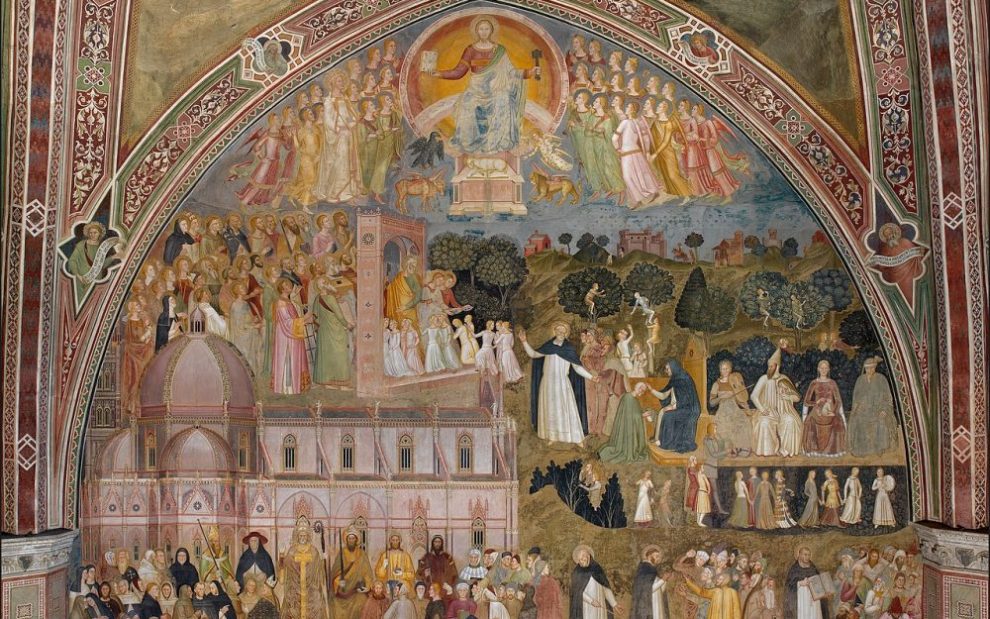It’s not without some degree of pride, and equal parts delight, that my children’s most requested bedtime song at the moment is the Litany of the Saints. I love this song. For me, it brings back memories of attending the Easter Vigil and sitting between my dad and grandfather, who always squeezed my hand when the verse got to St. Teresa. I loved the solemn melody of the song and its repetition; I loved hearing the names of saints familiar to me and those of new ones; I loved feeling a part of the communion, and recognizing the names of my family members and friends as well.
No doubt, my daughters have their own reasons for requesting the Litany, and considering that they’ve only heard my paltry rendition of it (it’s a hard song to sing: you try chanting “Lord have Mercy” in a minor key an octave lower than your voice range!) their enchantment has more to do with the ethos of the saints than the beauty of the arrangement.
While I was initially surprised that my children took such a liking to the song, it makes sense the more that I think about it. In addition to the Litany, they are drawn to children’s books and artwork depicting saints, and when we pass a church, they ask for the name of it, and if it’s a Saint Somebody or Another, they request details about their life. In all of this, the stories of saints capture them.
Children love stories, especially ones that transport them to different worlds, feature relatable characters with whom they can identify, and help them imagine different possibilities for themselves. All of these can be true in saint stories.
Here are examples of a few saint stories that are especially enjoyable for children.
St. Mary Magdalene
When I think of “kid friendly” saints, Mary Magdalene, who has often been mistaken for a prostitute, isn’t the first holy woman who comes to mind. And yet, she is my four-year-old daughter Esther’s self-professed favorite saint.
Esther first learned about Mary Magdalene after Mass one Sunday when my dad walked her around the church and Esther saw Mary in the eighth Station of the Cross, when Jesus met the women of Jerusalem. Ever since then, she often asks me to tell the story of Mary Magdalene, and here’s what I say:
Mary Magdalene was a follower and friend of Jesus. She came from the town of Magdala, but after meeting Jesus, she traveled with him through the region as he taught people how to love one another. Mary cared for her friend very much, and that’s why she stayed by his side as he died, even though it was very sad and scary for her. She helped Jesus’ mother bury Jesus, and when Mary Magdalene went back to check on his body and anoint him a few days later, she saw that it was missing. At first, she cried because she was worried and upset, but then an angel approached her and said: “Do not be afraid; Jesus has risen.” Then, as she was walking home, she met Jesus and was so happy. Jesus told her to tell his other followers the good news, which she did. Mary even wrote a book about Jesus’ life and teaching which was called the Gospel of Mary Magdalene.
I love being able to tell my daughters the story of Mary Magdalene because it is an inspiring illustration of friendship and commitment. Also, Mary’s story demonstrates the contributions of women to the early Christian movement, an aspect of history that is too often erased. The institutional church doesn’t always do a great job of elevating women’s voices, but through the stories that I choose to tell, I can (though I’ll save the primer on how the scripture canon was codified for a different day).
St. Therese of Lisieux
Seven-year-old me was devastated to learn that I am named after St. Teresa of Avila rather than St. Therese of Lisieux. Though I have long since come around to admiring the first female doctor of the church, my child self desperately wanted to be associated with “the little flower.” And while I can laugh about my enamoration with the saint whom I referred to as “the pretty one” now, I still see the appeal of St. Therese to children.
One story about St. Therese is that she admired the saints from a young age and wanted to be like them, but could not see herself doing big things, like becoming a martyr or traveling the world as a missionary. Instead, she committed to doing “little things with great love.” She responded with kindness to the perpetually grumpy sister in her convent. She didn’t complain about waking early, even though it was hard for her. She continued to pray even in moments of pain and doubt, when she might have been tempted to lose faith.
St. Therese’s spirituality of “the little way” reminds all of us—especially children, for whom I think it makes intrinsic sense—that we too can pursue the path to holiness through small acts of kindness and care on a daily basis.
St. Lucy
My children’s interest in St. Lucy began with a fear of the dark. We tried nightlights, we tried lamps, we tried keeping the overhead light glowing until they fell asleep, but the problem was that none of these solutions eliminated the darkness outside their bedroom windows. One glance through the crack in the blinds and terror struck my toddlers. That’s when I told them the story of St. Lucy, the patron saint of the darkest nights of the year.
St. Lucy was born in Sicily during the late third century, back when Christians were still persecuted by the Roman Empire and had to keep their faith a secret. When Lucy was a young girl, she embraced Christianity and decided that in lieu of marriage and motherhood she wanted to devote her life to caring for the poor. Not knowing her daughter’s commitment, Lucy’s mom arranged a marriage between Lucy and a Roman pagan, and that man grew very angry when Lucy refused to marry him and gave her dowry to people in need instead. In retaliation, he told the governor about Lucy’s Christian faith, and when Lucy refused to give up her faith, she was ordered to be burnt at the stake. Miraculously, the fire wouldn’t light, and the crowds watching the execution were stunned by both the miracle and by Lucy’s peacefulness and bravery in the face of such adversity. Furious at the spectacle, the governor ordered the guards to beat Lucy and cut out her eyes. Although Lucy eventually died, her eyes were restored before her burial. That’s why St. Lucy is now the patron saint of eyes and of dark nights: She shared the light of Christ with others amidst the darkness, and she reminds us that however dark the outside world might be, we carry the light of Christ inside of us.
It’s convenient that St. Lucy helped my children get over their fear of the dark, that St. Therese reminds them that they don’t have to complain about every little thing that doesn’t go their way, and that Mary Magdalene introduces them to a dimension of our church’s history that is, regrettably, often ignored. I’m a pragmatist and will take all the help I can get on the parenting and pedagogical fronts.
But these aren’t the primary reasons I’m telling my kids saint stories. No, I’m bringing the tales of the holy men and women of our church into their lives because they are enthralled and engaged by them. If I can lean on the communion of saints to educate and entertain my children, you better believe I’m calling on the canonized.
Image: Wikimedia Commons/Andrea di Bonaiuto, Church Militant and Church Triumphant













Add comment